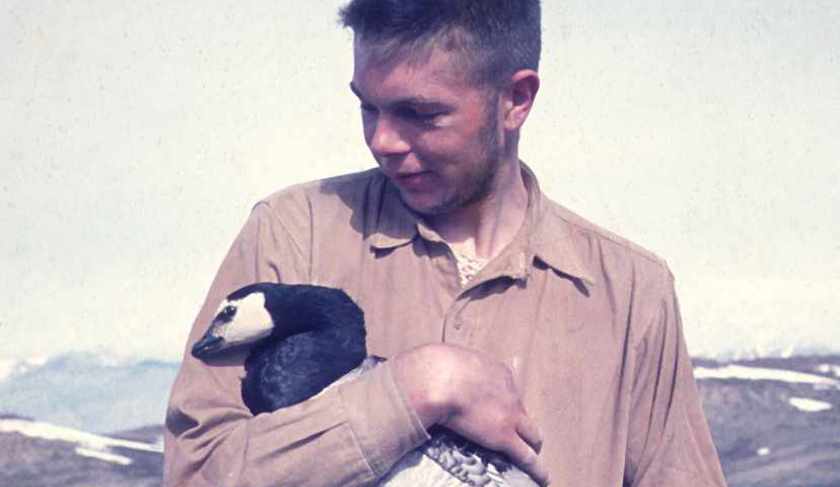Born: Hertfordshire, 15 May, 1941 Died: Ullapool, 24 April 2019, aged 78
Graham Charles George Argent, known as George to the botanical community, was appointed as Tropical Botanist on the staff of the Royal Botanic Garden Edinburgh (RBGE) in 1974.
After an undergraduate degree in botany from the University of Leicester (1963), he obtained a PhD on the taxonomy of West African mosses from the University of Wales, Bangor (1969), while working as a research assistant to Professor Paul Richards. He subsequently secured a position as Research Fellow for the New Guinea Biological Foundation, from 1969 to 1973, to collect and study the genetic diversity of bananas (Musa spp.). During this period, he travelled widely in Papua New Guinea and collected over 200 cultivars, which he subsequently propagated and studied at the experimental station of the Institute of Technology, Lae. During this time, he also made collections of artefacts from the many indigenous groups he met. This formed the basis of an exhibition in a large department store in Japan and much of this material was later donated to the National Museum of Scotland.
On appointment to RBGE, George commenced his research on the plant family Ericaceae, which includes the heathers, blueberries and his own speciality, the genus Rhododendron. His focus was on the tropical ‘Vireya’ Rhododendrons from South East Asia. Over the next 40 years, he authored more than 130 new species and varieties from a range of plant families, and published over 100 scientific papers, culminating in his seminal book Rhododendrons of Subgenus Vireya first published in 2006, with a second edition in 2015.
During his time at RBGE he undertook more than 50 expeditions across the tropics, bringing back thousands of preserved herbarium collections and introducing over 2000 living plants. It is perhaps for these living collections, recognised as the largest and best-curated collection of ‘Vireya’ Rhododendrons anywhere in the world, that he will be best remembered.
Although George took part in large expeditions, such as the Royal Geographical Society's Mulu expeditions (1977/78), Brunei Rainforest Expedition (1991/2), the Royal Society and Royal Geographical Society Brazil (Mato Grosso) expedition (1967/69), and an expedition to Los Tayos, Ecuador in 1976 - in which the astronaut Neil Armstrong took part- most of his fieldwork was undertaken in small groups. He particularly enjoyed being in the field with promising young researchers and many of those he helped and supported became significant botanists and conservationists in their own countries. Unusually for the time, he was also notable for including Edinburgh horticulturists on many of his expeditions, so that they could experience the natural environments in which species occurred, in order to reproduce these in cultivation.
Eight species, in seven different plant families, have been named in his honour (Acalypha argentii Sagun & G.A. Levin, Aeschynanthus argentii M. Mendum, Callicarpa argentii, Bramley, Musa argentii Gogoi & Borah, Nepenthes argentii Jebb & Cheek and Globba argentiana R.M. Smith, Begonia argentii Kiew & S.Julia, Begonia georgei Coyle). In 1997 he was awarded the Royal Horticultural Society’s Loder Cup for his major contribution to rhododendron research, in 2002 he received the American Rhododendron Society’s Gold Medal for a major contribution to international rhododendron research and in 2013 the David Fairchild medal for plant exploration.
After official retirement from RBGE, in 2004, his research on the Ericaceae and Musaceae of South East Asia continued unabated. He gave a keynote speech on the scientific importance of living collections at the Flora Malesiana Symposium (Edinburgh), in 2016, and a keynote presentation on New Guinea Musaceae at the international Zingiberales conference, in Singapore, in 2018. He continued to curate the Ericaceae of South East Asia in the Herbarium and the Living Collection. His last expedition was to Northern Luzon with the National Museum Manila in 2017, although he was actively planning an expedition to New Guinea for 2020. It was in retirement that he published the second edition of his acclaimed monograph on ‘Vireya’ rhododendrons, containing over 300 species. In the past year he published and submitted scientific papers describing new species from the Philippines, Lao and Indonesia, a checklist of Musaceae & Ericaceae of New Guinea and a major paper on the Vaccinium (blueberry relatives) of Borneo covering 42 species, 10 of which are described as new to science.
George was renowned for his kindness and generosity. He had a mischievous sense of humour and at times enjoyed testing institutional boundaries. He never seemed to lose his enthusiasm for foreign travel; his expeditions to some of the remotest places on Earth - often carried out on a shoe-string - were a rich source of anecdotes which amused his contemporaries and inspired younger generations of researchers. He is remembered with great fondness by the many botanists with whom he freely shared his immense taxonomic knowledge and by the numerous horticulturists who were given the opportunity to see species in their natural habitats. He is also remembered by a succession of talented botanical artists he nurtured, for whom he secured funding and who drew and painted some of the most interesting of his discoveries, both from living plants in the Glasshouses, and dried specimens in the Herbarium. George was the quintessential botanist, with the wide variety of skills and knowledge needed to thrive in a botanic garden research community and with a range of experience that would be hard to repeat today. He significantly enhanced the global reputation of the Royal Botanic Garden Edinburgh as a world leader in plant research, cultivation and conservation. He is survived by his wife, Sue, three children, Iain, Jamie and Jennifer, and two grandchildren, Emily and Tristan.
ENDS
(934 words)
Dr Peter Wilkie is Head of Sapotaceae Research, Royal Botanic Garden Edinburgh

George as a young man with a goose, in Greenland

